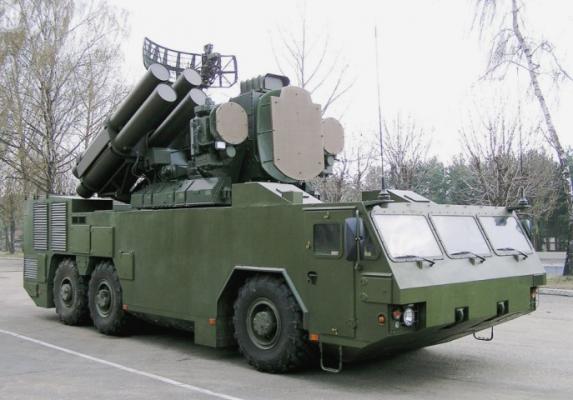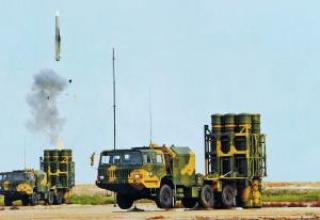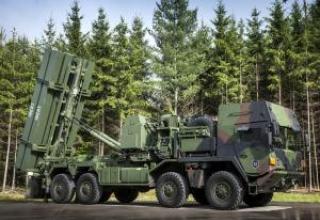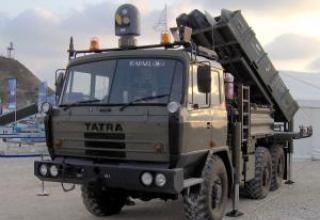Autonomous mobile short-range antiaircraft missile system (SAM) T38 "Stilet" is designed to protect units of ground forces, industrial and military facilities from attacks of all types of modern and advanced air attack vehicles with an effective scattering surface of 0.03 m ² and more, flying at extremely low, low and medium altitudes.
The complex was developed by the Belarusian scientific and production enterprise "Tetraedr" and is a logical continuation of the works of this enterprise under the program "Wasp-T", aimed at modernization of the outdated Soviet complexes "Wasp".
In contrast to the prototype, the T-38 air defense system is placed on the wheel chassis MZKT-69222T of high cross-country ability and uses a new anti-aircraft missile developed by the State Defense Committee "Luch" (Kiev, Ukraine) as a means of destruction. The control systems of the complex are made on the new element base, the combat vehicle is equipped with an electron-optical detection system.
Composition:
The Stilette SAM is a part of T38 Stilette SAMs:
Combat vehicles:
- combat vehicle (BM) T381;
- T382 antiaircraft guided missiles (SAMs).
Technical means:
- transport and charging machine (TZM) T383;
- alignment machine (HUM) T384;
- maintenance machine (MTO) T385;
- automated control and testing mobile station (AKIPS) T386;
- set of ground equipment (KNO) T387.
T38 "Stilet" SAM system provides detection and identification of targets on the move and in the parking lot, firing a target with one or two missiles in the parking lot or from a short stop.
High autonomy and mobility of the complex is achieved by placing the equipment and missiles on one wheel chassis of high cross-country ability.
The T381 combat vehicle is the main element of the SAM system. The combat vehicle is located on a self-propelled chassis MZKT-69222T with a running diesel engine YAMZ-7513 rated at 430 hp and automatic transmission.
It is equipped with means of navigation, topo-fixing, life support, communication and power supply of the complex.
Calculation of the fighting vehicle - four people.
The BM T381 is a part of the complex:
- radar stations:
- target detection station
- target tracking station
- dual channel scan
- dvu
- digital computing system
- automated calculation workplaces (see photo1, photo2, photo3, photo4)
- starting automation system and launcher
- functional monitoring equipment and combat training
- ECO combined system
- power supply system
- air conditioning and heating system SCO
- self-propelled wheeled chassis MZKT-69222T.
Radar Target Detection Station (TRC) of the complex can detect targets flying at an altitude of 5000 m, 40 km, at an altitude of 50 m - 27 km, at the same time TRC can detect 48 targets; range of the target tracking station (TSS) - 28 km.
The combined optical-electronic system (OES) has TV and thermal imaging channels and is equipped with a laser rangefinder. The combined optical-electronic system is capable of detecting MiG-29 type targets for 30 km via TV channel and for 35 km via thermal imaging channel and taking them for tracking at the distance of 20 and 22 km respectively.
Two-stage bicaliber solid fuel ZUR T382 is designed to defeat airborne attack vehicles. The rocket propulsion system consists of a launch accelerator (separated after launch) and a marching engine. The rocket's starting mass is 116 kg, length is 3158 mm, hull diameter is 108 mm, and engine diameter is 209.6 mm. During the entire period of operation, the missile is in a transport and launch container (TLC). Rudders and wings of the missile, located in the TPK, are X-shaped at an angle of 45 ° to the vertical plane. The weight of the missile in the TIC is 151 kg, length of the TIC is 3253 mm.
The combat unit - shrapnel and rod weight of 18kg, equipped with a non-contact active-type radio detonator. The area of operation of the radio detonator is coordinated with the area of destruction of the missile's combat unit. This alignment is achieved by introducing a time delay in the trigger area depending on the type of target (small, medium, large) and the predicted speed at which the missile will approach the target.
The flight speed of the SAM is up to 850 m/s, maximum overload is 25g, running time of the launch engine is 1.5s, marching engine is 20s.
TZM T383 (see photo) is designed to charge (discharge) missiles in the TPK combat vehicle T381, their temporary storage and transported .
The TZM can perform the following works:
- missile reloading from TZM to BM and vice versa
- transshipment of rockets from the on-board vehicle to the BM and TZM and back.
- loading of rockets onto and from a ground kit trolley
- Ground-to-ground transshipment of rockets to and from BM and TZM
- refilling of BM with fuel from additional tanks of TZM
- unlocking of the trigger
- replacement of defective missiles with a fully loaded TZM.
Number of transported missiles 1-24 pcs. Capacity of additional fuel tanks (total) 2×500l. Charging (discharging) time of BM 5 ... 8 min, crane capacity 850 kg.
The T384 alignment machine (see photo) provides alignment of the combat vehicle's antenna systems, checking and adjustment of individual BM T381 systems.
The alignment machine is part of the machine:
- telescopic tower on the chassis of a car (6x6)
- control equipment
- electrical equipment
- cable farm
- a single set of ZIP.
The T385 maintenance vehicle (see photo1, photo2) is designed to provide maintenance and routine repair of combat vehicle equipment. The vehicle provides maintenance of four combat vehicles in the field and in a joint repair shop.
It is provided with transportation of SAMs by IL-76 type aircraft and transportation by rail within the envelope of 02-T size.
Characteristics:
| Maximum inclined target range, km | 20 |
| Defeat height, km | 0,025 – 10 |
| Maximum course parameter for hit targets, km | 10 |
| Maximum target speed, m/s | 900 |
| Probability of hitting the target of one SSD | 0,90 |
| Minimum EPR of detectable targets, m² | 0,03 |
| Roll-up / deployment time, min | 5 |
| Total service life of air defense systems, years | 25 |
Testing:
It is alleged that two projectiles were launched towards the Israeli capital, the city of Tel Aviv, from Gaza on the evening of 15 November 2012.
The Palestinian terrorist organization Al-Quds Brigades, the militant wing of the Islamic Jihad, claimed responsibility for the shelling. According to their statement, two Fadjr-5 rockets were fired towards Tel Aviv, indicating that the group had hundreds of such rockets.












